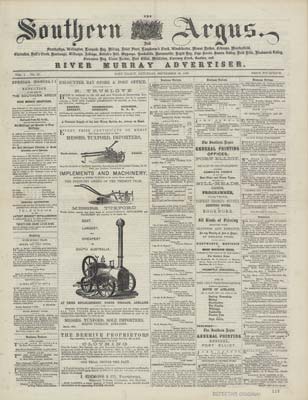
SA Newspapers : Country press

Is there a man with soul so dead,
Who never to himself hath said -
I will the local paper take
Both for my own and family's sake?
(Southern argus, 16 September 1875, p. 4)
The earliest country newspaper in South Australia was the Port Lincoln herald. The first issue of this title was published in Adelaide in April 1839, but in November of that year the second issue was published at Port Lincoln. The newspaper promoted the expected development of Port Lincoln as an important shipping port for the infant colony and ceased when this did not eventuate.
In 1843 John Stephens, a former employee of the Register, sent John Dickins to canvas the country districts to gauge whether a newspaper would find a ready market amongst the scattered rural population. The response was said to have been overwhelming, and so in 1843 the Adelaide observer began its almost 90-year run, published from the city, but originally aimed at a country readership. The next newspaper actually published in a country town was the German language Deutsche Post, also founded in Adelaide, but moving to Tanunda in 1850. It was the first of several newspapers produced in that town to serve the German-speaking population of the Barossa Valley. Despite the large mining community at Burra, and other early country settlements, overall South Australia's low rural populations meant it was some years before the country press consisted of more than these isolated and mostly intermittent attempts.
The 1860s saw the real birth of the country press with newspapers founded at Kapunda (1860), Mount Gambier (1861), Gawler (1862), Wallaroo (1865), Port Elliot (1866) and Clare (1869). This reflected an increasing population movement into newer country districts further from the city, which picked up pace after 1868 with changes to the system of government land sales. It was at this time that land was first sold on a credit basis, as opposed to the original cash only system. Consequently further agricultural expansion took place in the 1870s, particularly in the mid-north, which saw newspapers founded at Burra, Port Pirie, Port Augusta, Gladstone, Jamestown and later at Terowie, Peterborough and Laura. In the south east, the Naracoorte herald was founded, and the Tatiara mail at Bordertown.
A principle shared by all country newspapers was the relentless promotion of district advancement. Whether it was extension of the railway network, building of reservoirs and shipping facilities, or the furthering of services, or beautification of the town. At times there was strong competition with neighbouring districts, particularly for such advantages as railway building. The newspaper proprietor (who was often also the editor, chief reporter and even printer) of course had a personal financial interest in the development and prosperity of the district. Some newspaper men entered local government, or occasionally entered Parliament.
Despite the effects of the 1890s drought, the years immediately prior to the First World War continued to see an expansion of the country press. Newspapers were established at such places as Orroroo and Quorn, as well as James Barclay's various titles in the mid-north of the state. Further newspapers were founded in the Copper Triangle, at Yorketown and Maitland, at Pinnaroo and on Kangaroo Island. The number of country newspapers being published in South Australia peaked shortly before the outbreak of War. However, small populations and large distances had always made country newspaper publishing an expensive business. Following the First World War, increased motor travel and growing mechanisation on farms saw rural populations becoming more mobile and decreasing as rising generations and retiring generations were drawn away to the city or larger centres. Rural newspapers began to amalgamate or close.
Following the Second World War the number of country newspapers initially remained relatively constant. Further amalgamations of country newspapers occurred from the 1970s, and although today some titles - notably the Southern argus, Naracoorte herald, Plains producer and the Mount Barker Courier - have remained family concerns, most other country newspapers have become part of the New South Wales based Rural Press organisation. The Taylor family of Renmark have formed a smaller, local corporation consisting of the Murray pioneer, Border times, Bunyip, Loxton news, Mid North Broadcaster and River news.
Hugo, G.J. South Australian country newspapers, 1839-1971: a preliminary list and survey, Adelaide, S. Aust.: Royal Geographical Society of Australasia, SA Branch, 1971
Marquis, Len. South Australian newspapers: a selection of material from the extensive research notes gathered for a proposed history of the press in South Australia by Leonard Stanley Marquis/ prepared by Ronald Parsons, Lobethal, S. Aust.: Ronald Parsons, 1998
Walker, R.B. The newspaper press in New South Wales 1803-1920, Sydney: Sydney University Press, 1976


